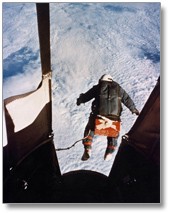The Original Space Jump

By Samba Lampich
October 14, 2012, was the day Felix Baumgartner made headlines with his record-breaking jump. His 23-mile-high jump would not have been possible without pioneers like Joe Kittinger who had ventured where no man had gone before.
In August 1960, 32-year-old Captain Kittinger jumped off an open gondola supported by large helium balloons that had carried him 19 miles above the Earth.
Preparing for Success
Kittinger was assigned to the Air Force’s Project Excelsior, which was designed in part to study high-altitude bailouts. His first jump, Excelsior I in February 1959, almost ended in disaster when he lost consciousness. The second jump in December 1960, Excelsior II, was a success that led to his third record-breaking jump six months later. Kittinger breathed only pure oxygen for hours before his ascent to cleanse his blood of nitrogen gas, which can cause the “bends," a condition when nitrogen expands painfully and even fatally at altitude.
The Silent and Lonely Ascent
During the ascent, the pressurization in Kittinger’s right glove failed and his hand began to swell to reach nearly twice its normal size. He recalled a feeling of awe and remoteness as the open-door gondola floated higher into the atmosphere. At X-minus-70-seconds, he dropped the trailing antenna so he wouldn’t land on it, cutting all communications with the ground crew and leaving him all alone.
Jumping into History
Uttering the words, “Lord, take care of me now,” Kittinger stepped out of his open-air, helium-balloon gondola, some 20 miles (31 kilometers) above Earth. He was in freefall for 4 minutes and 36 seconds, reaching a maximum speed of 614 miles per hour (988 km/h) with nothing but a small stabilizer parachute protecting him from spiraling out of control to his death.
In the December 1960 issue of National Geographic magazine, Kittinger said, “At zero count I step into space. No wind whistles or billows my clothing. I have absolutely no sensation of the increasing speed with which I fall."
At 17,500 feet (5,300 meters) he deployed his main parachute and had a hard but safe landing. Kittinger’s record-breaking jump lasted 13 minutes and 45 seconds.
Kittinger was involved in the 2012 Red Bull Stratos project, serving as mentor and Capcom I, the voice that links the ground Control Center with the pilot.
Classroom Discussion
- What effects do high altitude and low pressure have on the human body?
- How are spacecraft designed to reenter the Earth's atmosphere without burning up?